Are you looking to learn what product managers (PMs) & product owners (POs) are and how they differ? Search no further! In the roles of a technical product manager vs product owner article, we will cover everything you need to know. As well as a bit of product manager vs project manager vs product owner vs project manager insights.
Over the years, the technology world has advanced beyond measure. Organizations have transitioned from simple products with a few features to developing complex solutions. A typical product involves hybrid technologies and can perform complex functions. Much work and expertise go into building and maintaining feature-rich, fast, and reliable products.
As a result, product engineers have evolved to meet the current demands for feature-rich, complex products. From conceptualizing a product to development and maintenance, they all involve engineers with different skills and expertise. So, a development team breaks down into subteams (like designers, developers, and QA experts), each focusing on a given part of the product.
For these teams to achieve the company’s goals, they have to collaborate and work as one. If they work as islands, they can’t achieve a common goal.
This is where product managers and product owners come in. They are product experts who help foster collaboration among sub-teams and ensure everyone is working towards the main goal.
Product managers and product owners play the vital roles of ensuring the delivery of great products that captivate customers. However, the roles are different.
This article will explain the difference between a product owner a product manager. Keep reading!
Table of contents
- What is a Product Manager?
- What is a Product Owner?
- Product Manager Roles and Tasks
- Product Owner Roles and Tasks
- Product Owner vs. Product Manager: Differences
- Advantages of Counting on a Product Owner vs Product Manager
- Project Manager vs. Product Manager vs. Product Owner
- How Your Company Benefits from a Project Manager
- Product Manager vs Product Owner Summary
- Conclusion
- FAQs
What is a Product Manager?
A product manager is responsible for ensuring the successful delivery of a product. By using product management tools, this strategic role involves conducting user research and determining the features a product will include. In addition, a product manager coordinates the team to achieve the organization’s goals, designs a long-term product strategy, and creates a product roadmap.
A product manager analyzes the market to gain business insights, which helps in building a product that will be successful in the market. Product managers often possess the technical background needed to transform user stories. The person who occupies this position is the link between other stakeholders and the development team.
What is a Product Owner?
A product owner acts in the interest of the client and end-users to ensure that developers do what they are supposed to do at every phase of product development. The Product Owner role covers the management of a product’s backlog, which outlines required tasks. A product owner makes the development team focus on the right tasks – according to the product strategy created by the product manager.
The product owner is a role in the Scrum Framework, a subset of the agile methodology. According to the Scrum Guide, the definition of a product owner is:
“The Product Owner is accountable for maximizing the value of the product resulting from the work of the Scrum Team. How this is done may vary widely across organizations, Scrum Teams, and individuals. The Product Owner is also accountable for effective Product Backlog management…”
Read our blog, Software engineering principles.
Product Manager Roles and Tasks
To understand the debate between technical product owners vs product managers, let’s review their roles. Even though product managers and product owners have some things in common, there is a difference between product owner and product manager. That said, let’s take a look at the tasks they perform in organizations.
The roles of a product manager vary from company to company. Factors like the size of the company and the type of project determine what roles a product manager plays. Here are the major responsibilities of product managers:
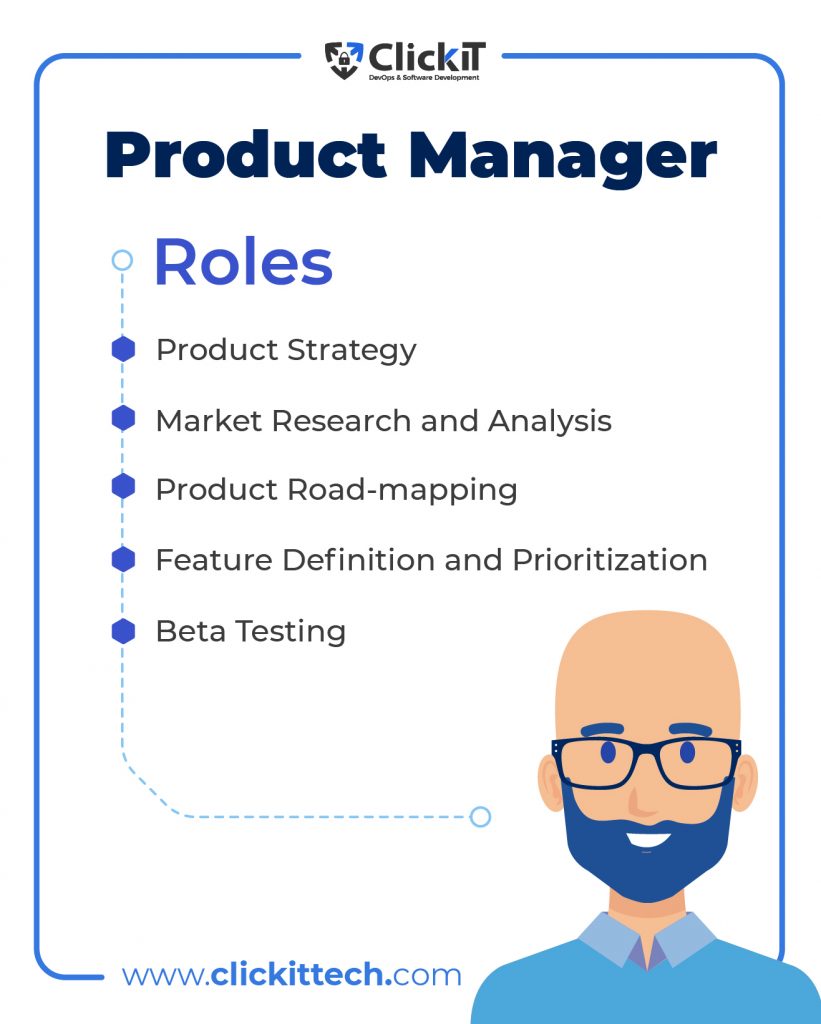
Product Strategy
Creating the product strategy and vision is one of the fundamental roles of a product manager. Depending on the product type and how the company operates, the person leverages vital metrics to develop a strategy for product development. This is also ongoing as the product manager continues to devise strategies to optimize product performance using customer feedback tools and market trends.
Market Research and Analysis
The business world is complex and ever-changing. Relying upon old data to build a product is a recipe for failure. This is why market research and analysis are part of what product managers do to ensure the accomplishment of customer needs. Through customer feedback, surveys, and other forms of research, PMs get the insights they need to build successful products.
Product Road-mapping
PMs are responsible for creating product roadmaps. Road mapping determines what the company wants to achieve and the actionable steps to achieving the goals. In collaboration with engineers, they create the roadmap for every phase of development. Typically, the product roadmap is subject to changes when feature specifications change or technical issues arise.
Feature Definition and Prioritization
Guess who determines what features to include and when to build them? You are right, product managers. The decisions of a PM are data-driven. This means that customer feedback and market trends help determine the features included in a product. PMs work with engineers and stakeholders to include important features and build the best products possible.
Beta Testing
The development team validates a product’s capabilities through beta testing. Conducted by QA engineers, beta testing ensures a product performs properly. A product manager supervises the testing process to ensure it’s thorough implementation. This phase is crucial as it helps boost the chance of launching a successful product.
Launch and Post-Launch Activities
A product manager participates actively in the product launch phase. From marketing to sales preparation, the PM ensures the product’s successful launch. Sales performance and what users say about the product are tracked and used to improve the product. In addition, a PM oversees post-launch activities, like product update, bug fixes, and ensuring the product remain competitive.
You can also read our blog on How to Build a Software Development Team.
Product Owner Roles and Tasks
The Scrum guide defines Product Owners’ roles. Here are the tasks a PO performs in a Scrum-based team:
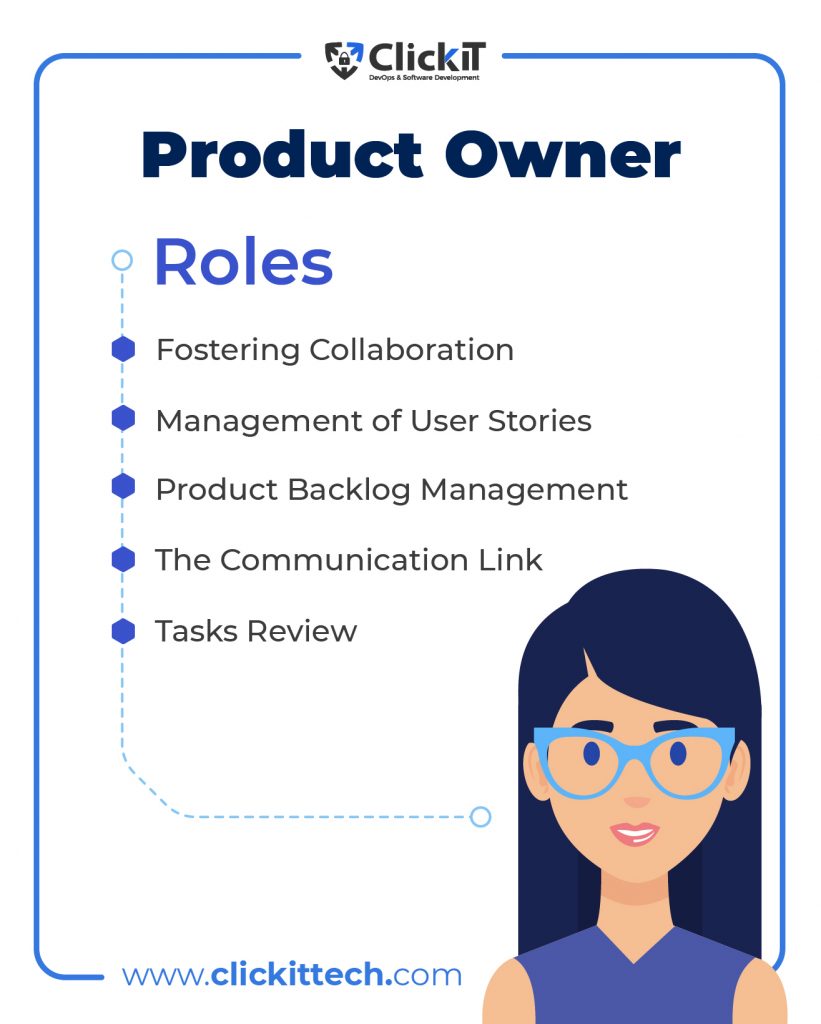
Fostering Collaboration
Product development involves a number of experts. It’s easy to lose touch with other workers if the team is big. One of the major roles of POs is to make sure that designers, developers, and every engineer on a project work together to deliver a great product. In other words, product owners work hand in hand with business stakeholders and engineers to build a solution according to the product’s roadmap.
Management of User Stories
Another product owner role is, creating and managing user stories. User stories help developers create features perfect for end users. User stories are explanations of product features from the end-user’s point of view. A PO understands customers’ wants and uses user stories to tell developers what to build.
Product Backlog Management
Also known as backlog grooming, involves a process in which stakeholders and PMs meet to look at the backlog’s content. This is to review the items in the backlog. Old user stories are removed and replaced with new ones. Additionally, they arrange tasks based on priority.
The Communication Link
One of the product owner’s roles is to serve as the communication link between the customer and the development team. Similarly, the PO stands between the developers and other stakeholders. When confusion or questions arise, the development team relies upon the PO for clarification. This constant exchange of information keeps everyone in the loop and facilitates the creation of flawless products.
Read our blog about the top 10 Software development KPIs.
Tasks Review
A product owner doesn’t stop at creating user stories; the person is also responsible for ensuring the engineers develop the features properly. By checking the completed work, a product owner ensures the fulfillment of every criterion. In cases where some things are left out, PO draws developers’ attention to them.
Product Owner vs. Product Manager: Differences
In this section, we’ll explore the difference between product manager and product owner.
Product Owner Roles are Scrum-Based, While Product Manager Roles are Not
A product owner is a position that only exists in the Scrum Framework. And there is no product owner in project teams that are not using Scrum-based methodology. On the other hand, the product manager position is not limited to the Scrum framework. Any product development project requires a PO – whether they have the official title or not.
A Product Manager Takes Care of the Entire Development Cycle
While product managers are responsible for managing the entire product development lifecycle, product owners’ roles don’t go beyond the Scrum-based development lifecycle. In other words, the roles of PMs are broad (from road mapping to beta testing, launch, and post-launch activities), while those of POs are narrower – as defined by the Scrum Guide.
A Product Manager is More Collaborative
According to the Scrum Guide, the product owner can independently make decisions about product features without supervision. The company is expected to believe or accept that the PO is competent enough to deliver great results. In contrast, a PM employs a collaborative decision-making strategy.
The biggest difference between product owner and product manager is that the PO position doesn’t exist outside the Scrum Framework. But the PM position exists in any product development team.
Advantages of Counting on a Product Owner vs Product Manager
Next, we’ll look at the advantages of having a product owner vs product manager.. Whether you have one or both positions in your organization, you stand to enjoy a range of benefits.
Key Benefits of having a Product Manager
Better Collaboration
To build a product that aligns with your company’s goals, developers and other professionals must work as one team. The product manager fosters collaboration and helps all experts to be on the same page. A PM creates a structure that defines everyone’s role and minimizes the ambiguity of having people from different professional backgrounds on the same project.
Building a Customer-First Product
No matter how feature-rich a product is, it won’t be successful if it doesn’t properly help the target market. To avoid building a solution that doesn’t appeal to the customers, PMs do market research to find out what the customers want. And collaborate with developers that include features that solve critical problems in the market.
Higher Chances of Success
Having a product manager in a project doesn’t totally remove the probability of the product failing. However, the roles a PM plays help to boost the chances of building a successful product. In other words, a product manager substantially reduces the risk of product failure. This is because PMs stay in touch with customers and market trends to ensure the development of suitable, competitive products.
Efficient and Organized Development Process
A product manager creates the product strategy that guides the engineers during development. Everyone knows what is expected of them and how accomplishing tasks affects other team members and the project. PMs keep the entire process efficient and organized, from developing the product strategy to market research, beta testing, and post-launch optimization.

Key benefits of having a Product Owner
Availability for Daily Communication
A product owner bridges the gap between the development team and other stakeholders. For proper collaboration to happen, there is a need for consistent communication among the parties involved. A PO answers developers’ questions and ensures they follow the product roadmap. POs keep everyone updated about the product.
Better Collaboration
What happens when a product owner keeps everyone updated? Every designer or developer on the project will understand their chores and work with others to deliver a great product. In the Scrum Framework, the product owner position is instrumental to the project’s success. And fostering collaboration is a major advantage of having a PO.
Improved Supervision
A product manager keeps tabs on what the development team is doing to ensure it properly captures user stories. When a PO finds out that a feature needs inclusion or optimization, he ensures developers pay attention to it. In a nutshell, POs supervise daily progress to ensure the completion of every task or milestone.
Next, we’ll compare a project manager with a PM and a PO. What is a project manager, and what roles does the person play in a company?
Project Manager vs. Product Manager vs. Product Owner
Now to enter the debate between product owner vs project manager vs product manager. A project manager is responsible for managing a project with a defined scope, a start, and a finish. The person is well-trained with certifications like PMP training and has the skills to plan and execute a project. A project manager executes a project from start to finish, ensuring deadlines and KPIs are met.
Even though these three positions are closely related, each is distinct. And the positions to include in a project depend on the size of an organization and the complexity of the project. In some instances, a product manager performs the duty of all three.
While a project manager is responsible for managing (planning, procurement, and execution) the project, a product manager is responsible for the entire lifecycle (from developing product strategy to customer research and product launch) of the product being built in the project.
The roles of a project manager vs product owner are significantly distinct. While the project manager focuses on ensuring the project’s success, a product owner works directly with the engineering team to ensure the product is built according to the product roadmap.
Transform your business with the expertise of our project managers. Contact Us!
How Your Company Benefits from a Project Manager
Now, when we talk about product owner vs project manager vs product manager we should focus on having a well-trained professional take up the project management role is significantly beneficial. Here are the ways your company can benefit from a project manager:

Good Management of the Budget
Every project needs adequate financing. And having a massive budget doesn’t automatically translate to efficient project execution. When funds are not properly managed, your company can run out of resources at critical stages of the project. With a good project manager, funds are appropriately channeled, and your project is executed cost-effectively.
Great Time Management
One of the major responsibilities of a project manager is to ensure that project deadlines and KPIs are met. The more time a project takes, the more money your company needs to keep things running. A project manager ensures that a project doesn’t stay longer through good planning and the provision of necessary resources.
Management of Project Challenges
Every project has peculiar challenges and potential risks. When there is no professional to address challenges proactively, things are about to get out of hand. This explains why projects fail. A good project manager identifies risks and implements measures to avoid them.
Product Manager vs Product Owner Summary
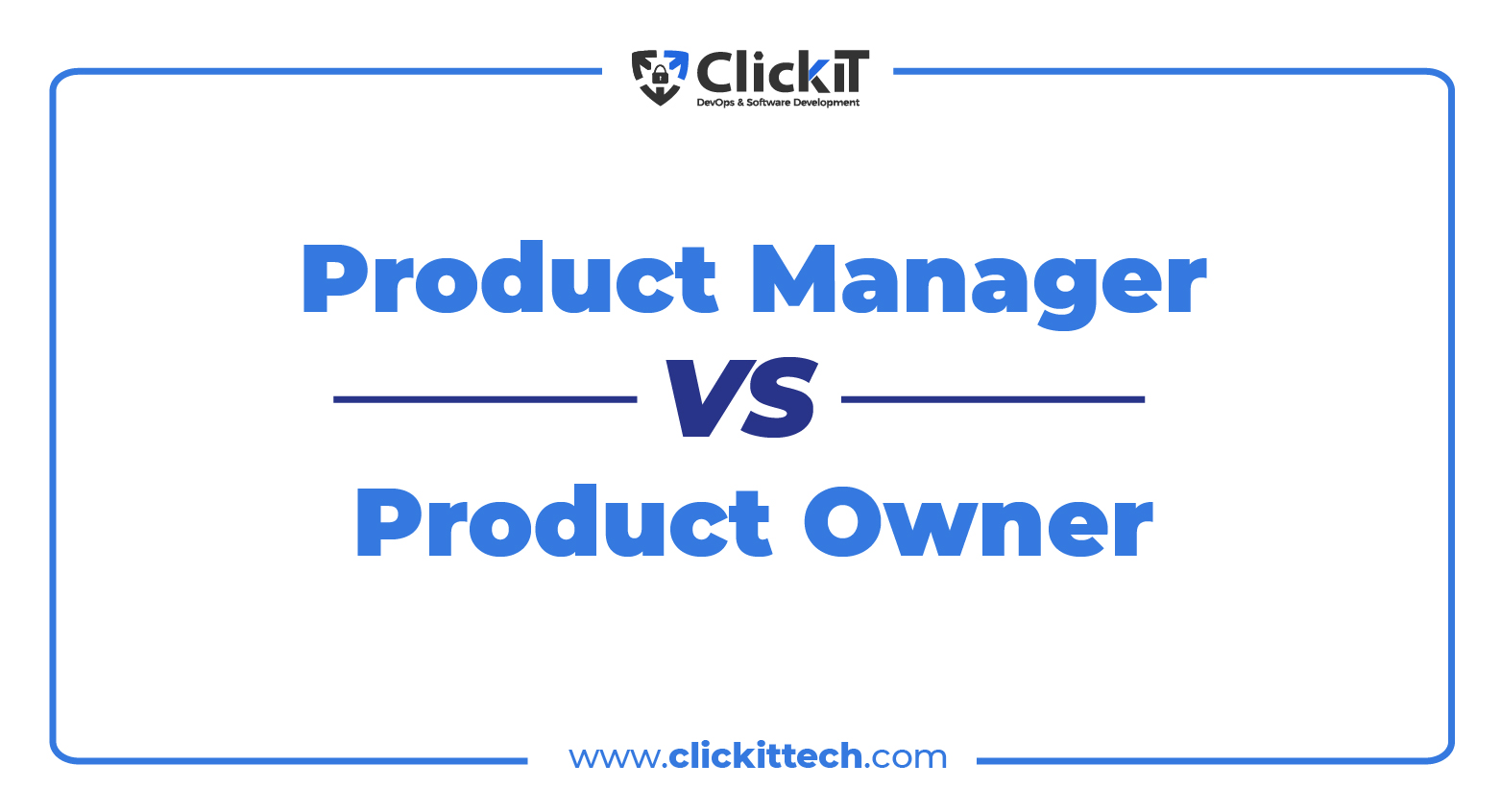
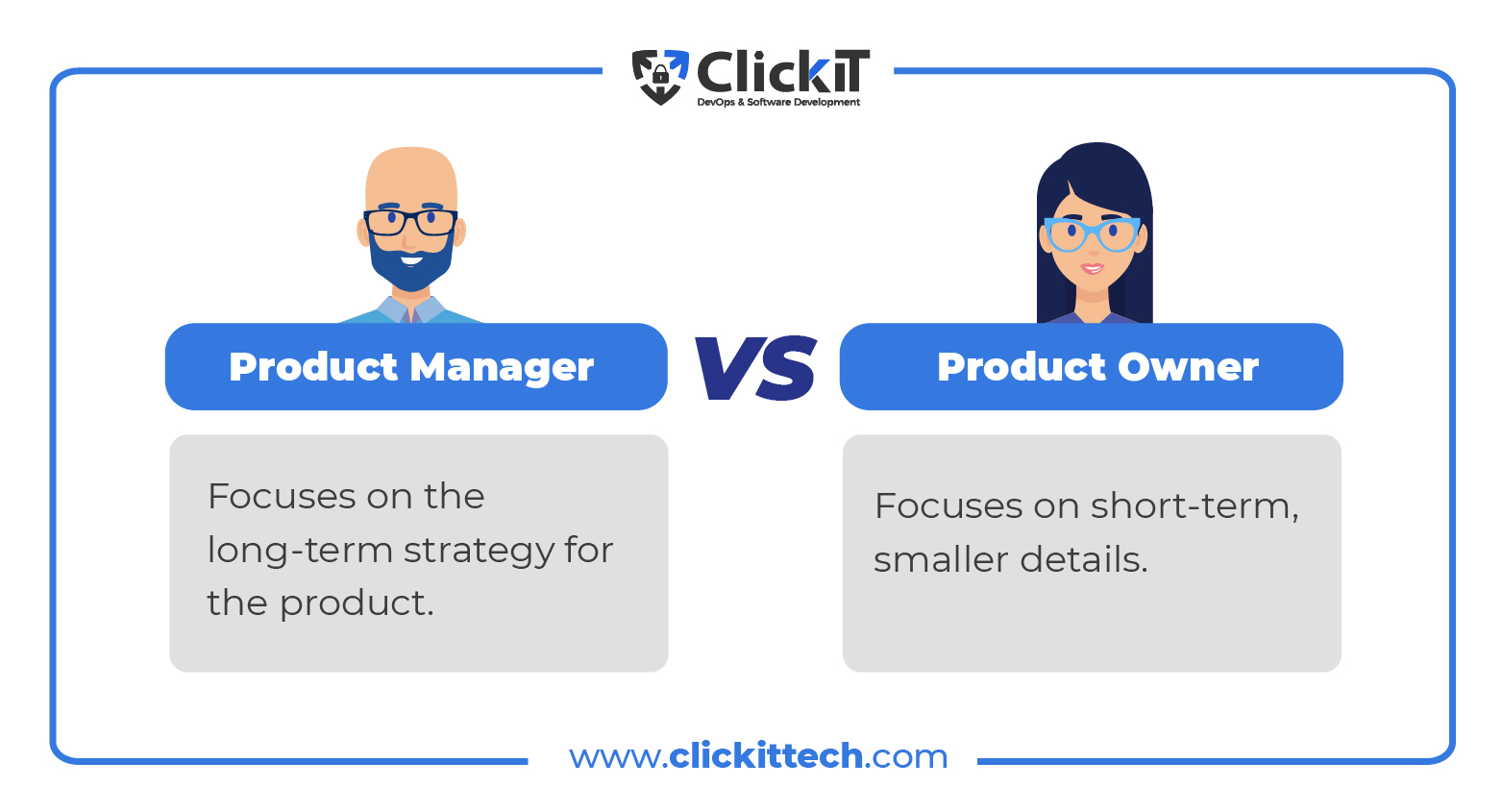

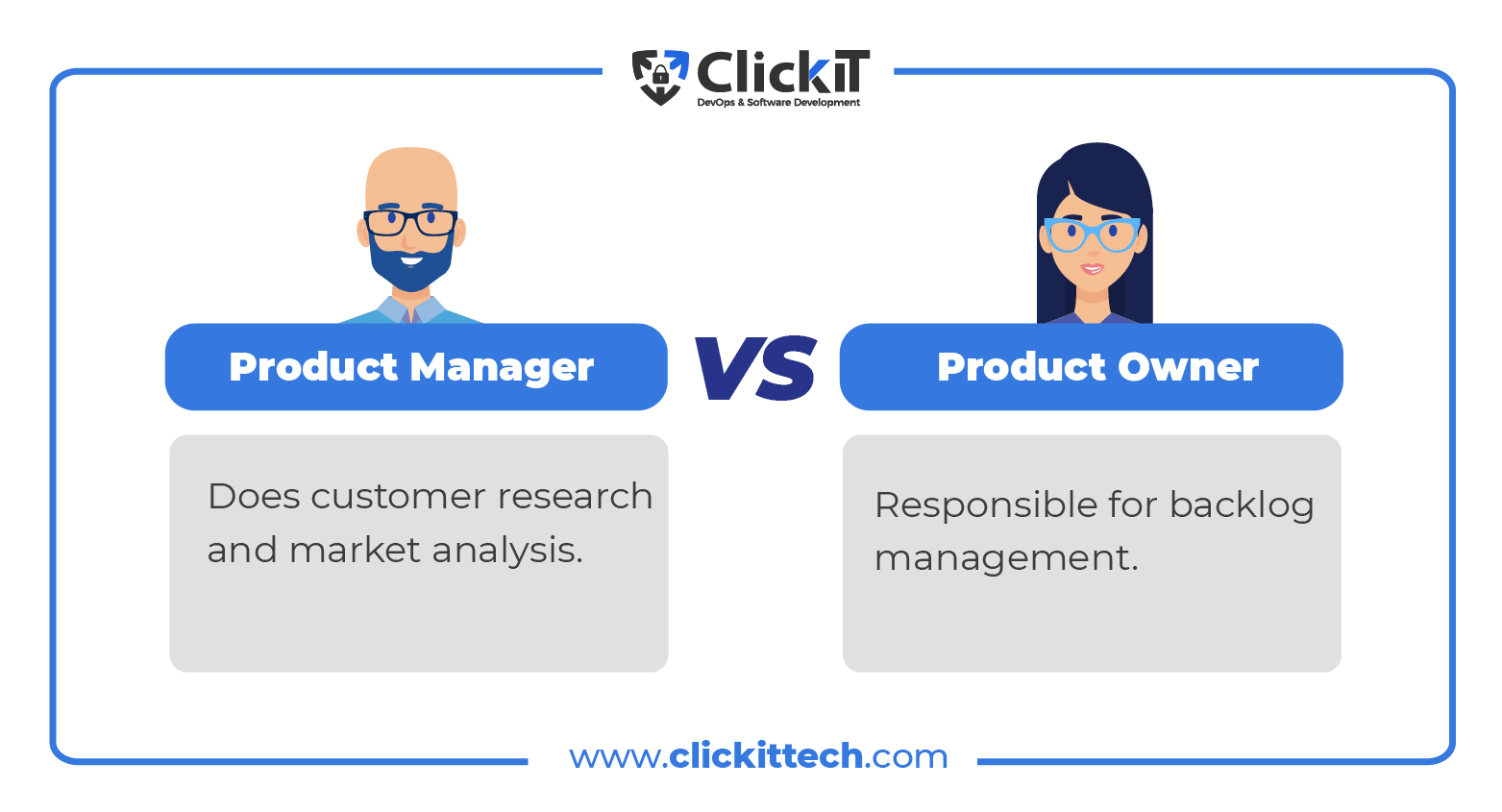
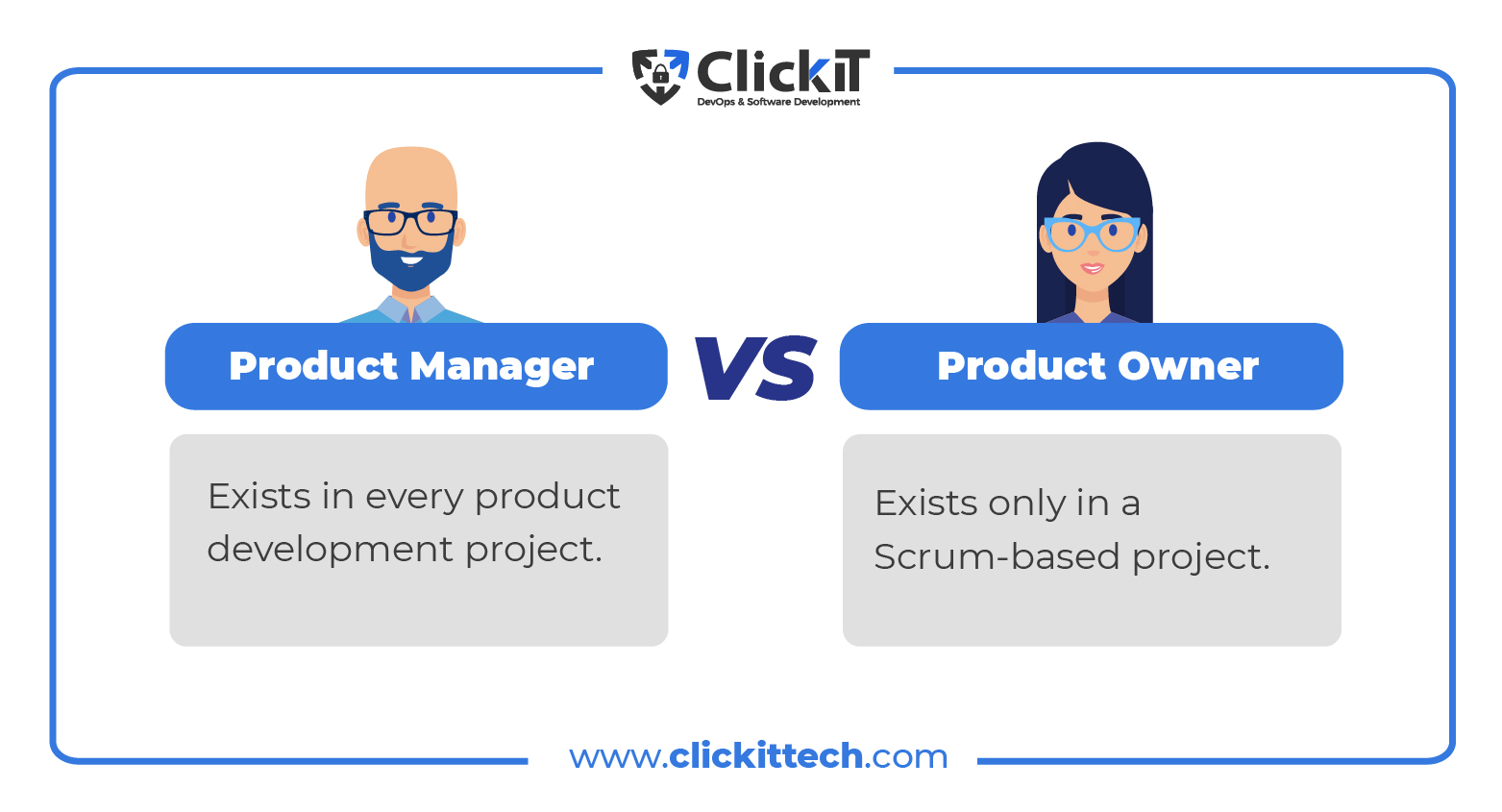
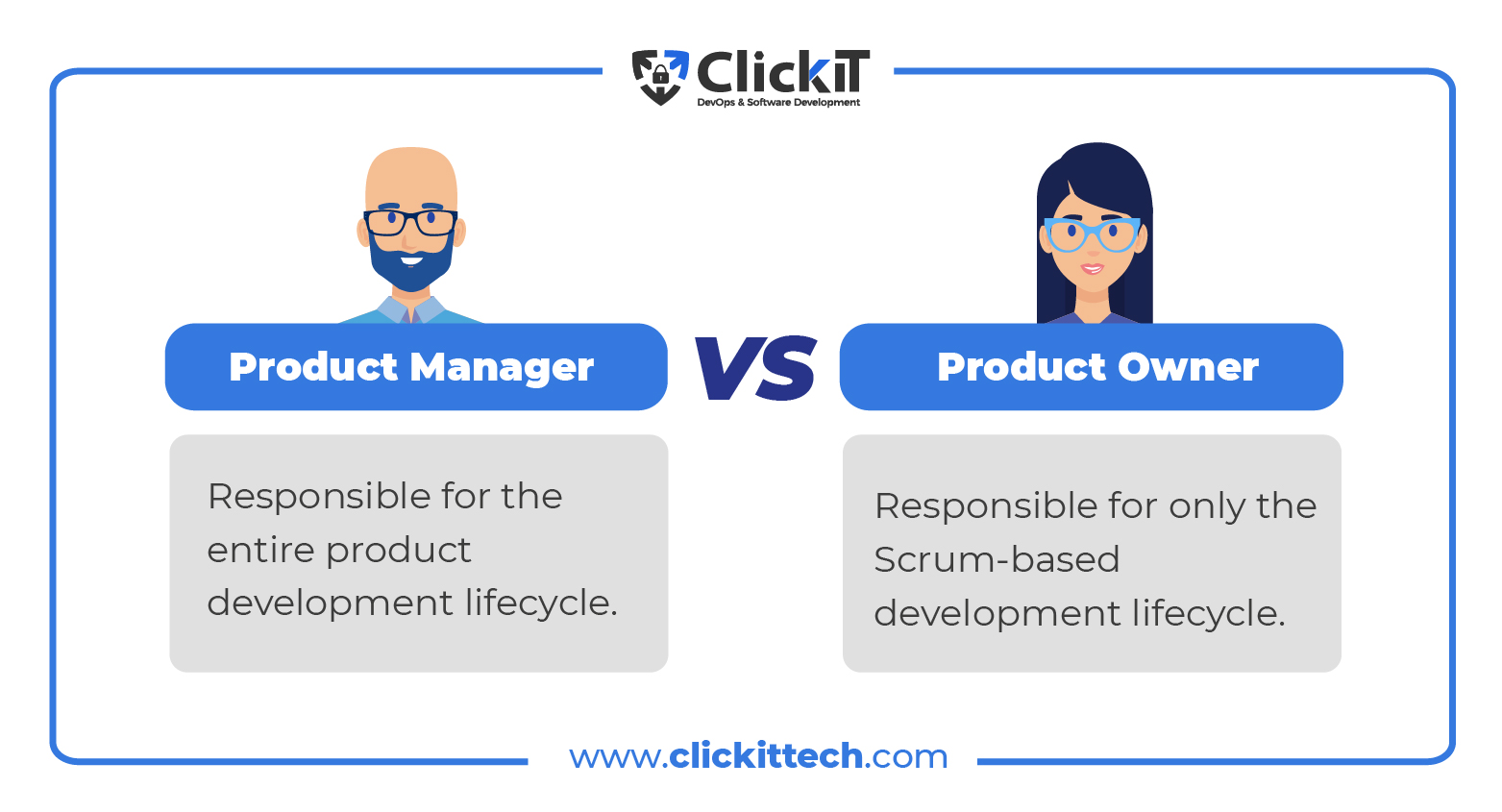
Conclusion
Product managers and product owners improve product development processes and boost the chances of building successful products. Depending on your project or company preference, you may choose to have both positions (if you implement the Scrum Framework) or work with a product manager only.
If you are finding it difficult to decide the best product development approach or want to learn more about Product Manager vs Project manager vs Product Owners, talk to us at ClickIT, the best DevOps Nearshore team. We can help you assess your project and recommend the best approach.
We stand out because we help businesses build robust, secure, and high-quality software-based applications designed to increase productivity and efficiency. Contact us today to learn more about our services and how we can help you.

FAQs
The PM is responsible for the overall strategy and vision of the product. They analyze market trends, gather user feedback, prioritize features, and work closely with cross-functional teams to ensure the product aligns with business goals.
On the other hand, the PO focuses on translating the product vision into actionable tasks for the development team. They create and manage the product backlog, write user stories, and provide clear guidance on what needs to be built in each sprint. The PO acts as a bridge between stakeholders and the development team, ensuring that requirements are met, and changes are effectively communicated.
A product owner makes sure the development team does the needful. The person is also responsible for creating user stories and managing the product backlog.
Yes! A product manager can also become a product owner. Both roles involve understanding customer needs, prioritizing features, and collaborating with cross-functional teams.
However, it’s important to note that the Product Owner role typically involves more hands-on involvement in the development process, such as managing the backlog and working closely with the development team.
The hierarchy between a Product Owner and a Product Manager can vary by organization.
In some organizations, the Product Manager may be considered higher due to their strategic focus, while in others, they may work together as peers or with the Product Owner in a more prominent role in day-to-day development activities.
No, a product development team can do without a product owner. The role of a PO only exists in the Scrum Framework. Not every company uses Scrum.
In a DevOps setting, the roles of Product Owner and Product Manager maintain their core responsibilities. But, they are adapted to foster tighter collaboration between development and operations teams, ensuring a streamlined and continuous delivery process.









